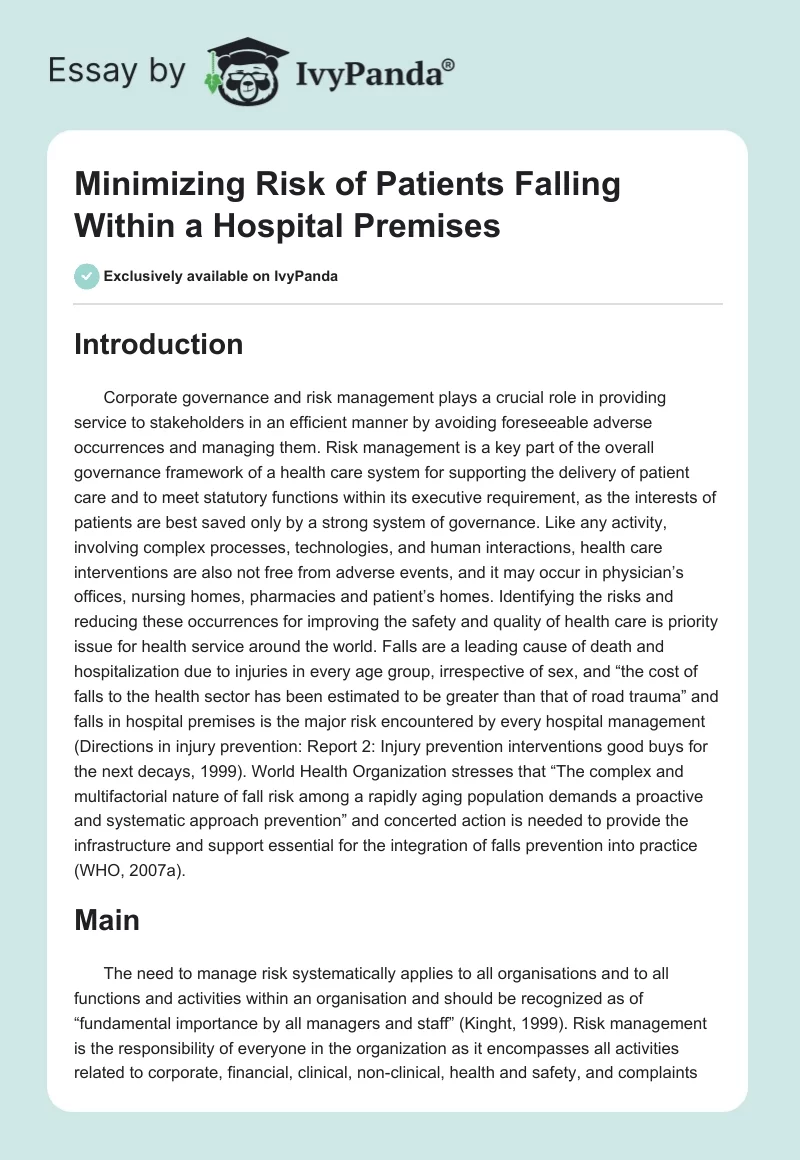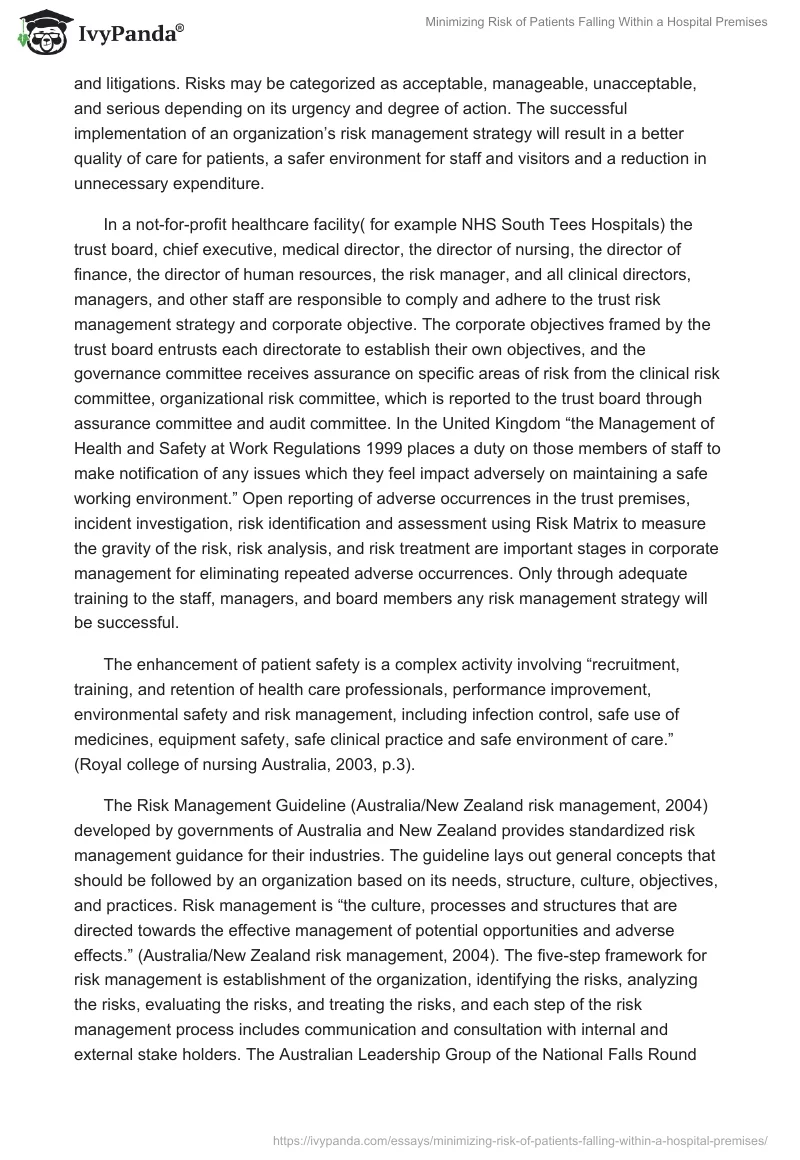Introduction
Corporate governance and risk management plays a crucial role in providing service to stakeholders in an efficient manner by avoiding foreseeable adverse occurrences and managing them. Risk management is a key part of the overall governance framework of a health care system for supporting the delivery of patient care and to meet statutory functions within its executive requirement, as the interests of patients are best saved only by a strong system of governance. Like any activity, involving complex processes, technologies, and human interactions, health care interventions are also not free from adverse events, and it may occur in physician’s offices, nursing homes, pharmacies and patient’s homes. Identifying the risks and reducing these occurrences for improving the safety and quality of health care is priority issue for health service around the world. Falls are a leading cause of death and hospitalization due to injuries in every age group, irrespective of sex, and “the cost of falls to the health sector has been estimated to be greater than that of road trauma” and falls in hospital premises is the major risk encountered by every hospital management (Directions in injury prevention: Report 2: Injury prevention interventions good buys for the next decays, 1999). World Health Organization stresses that “The complex and multifactorial nature of fall risk among a rapidly aging population demands a proactive and systematic approach prevention” and concerted action is needed to provide the infrastructure and support essential for the integration of falls prevention into practice (WHO, 2007a).
Main
The need to manage risk systematically applies to all organisations and to all functions and activities within an organisation and should be recognized as of “fundamental importance by all managers and staff” (Kinght, 1999). Risk management is the responsibility of everyone in the organization as it encompasses all activities related to corporate, financial, clinical, non-clinical, health and safety, and complaints and litigations. Risks may be categorized as acceptable, manageable, unacceptable, and serious depending on its urgency and degree of action. The successful implementation of an organization’s risk management strategy will result in a better quality of care for patients, a safer environment for staff and visitors and a reduction in unnecessary expenditure.
In a not-for-profit healthcare facility( for example NHS South Tees Hospitals) the trust board, chief executive, medical director, the director of nursing, the director of finance, the director of human resources, the risk manager, and all clinical directors, managers, and other staff are responsible to comply and adhere to the trust risk management strategy and corporate objective. The corporate objectives framed by the trust board entrusts each directorate to establish their own objectives, and the governance committee receives assurance on specific areas of risk from the clinical risk committee, organizational risk committee, which is reported to the trust board through assurance committee and audit committee. In the United Kingdom “the Management of Health and Safety at Work Regulations 1999 places a duty on those members of staff to make notification of any issues which they feel impact adversely on maintaining a safe working environment.” Open reporting of adverse occurrences in the trust premises, incident investigation, risk identification and assessment using Risk Matrix to measure the gravity of the risk, risk analysis, and risk treatment are important stages in corporate management for eliminating repeated adverse occurrences. Only through adequate training to the staff, managers, and board members any risk management strategy will be successful.
The enhancement of patient safety is a complex activity involving “recruitment, training, and retention of health care professionals, performance improvement, environmental safety and risk management, including infection control, safe use of medicines, equipment safety, safe clinical practice and safe environment of care.” (Royal college of nursing Australia, 2003, p.3).
The Risk Management Guideline (Australia/New Zealand risk management, 2004) developed by governments of Australia and New Zealand provides standardized risk management guidance for their industries. The guideline lays out general concepts that should be followed by an organization based on its needs, structure, culture, objectives, and practices. Risk management is “the culture, processes and structures that are directed towards the effective management of potential opportunities and adverse effects.” (Australia/New Zealand risk management, 2004). The five-step framework for risk management is establishment of the organization, identifying the risks, analyzing the risks, evaluating the risks, and treating the risks, and each step of the risk management process includes communication and consultation with internal and external stake holders. The Australian Leadership Group of the National Falls Round Table developed strategic policy direction for falls prevention, and the report titled ‘National Falls Prevention for Older People Plan: 2004 Onwards’ is cohesive and comprehensive response to the problem of falls and injuries among older persons (WHO, 2007a).
Falls are the most common type of inpatient accident that affect young as well as older patients, and previous studies have identified “impaired balance or gait, history of falling, increasing age, impaired cognition, depression, dizziness or vertigo, orthostatic hypertension, visual impairment, urinary frequency, nocturia, incontinence, specific diagnoses, and use of certain medications, such as benzodiazepines, antipsychotics, and sedatives” as major risk factors for falling in the hospital premises (Krauss, et al, 2005). Patient falls are a leading cause of adverse events resulting in increased length of hospital stay and increased costs, and physical harm resulting from it contribute to emotional injury and decreased quality of life. Studies to identify circumstances of fall found that “82% of hospital falls occur in the patient’s room, 85% are unassisted, and 47% are associated with toileting-related activities.” (Krauss et al, 2007).
World Health Organization defines fall “as an event which results in a person coming to rest inadvertently on the ground or floor or other lower level,” Morris and Isaacs define fall as an “untoward event in which the patient came to rest unintentionally on the floor,” and some definitions specifically include assisted falls, or falls in which the patient comes to rest on any surface lower than the patient’s original position, and variation in fall definition can have large effect on the recorded fall circumstances and rates for a hospital (quoted by Krauss et al, 2007). Studies, conducted in nine not-for-profit organization providing healthcare services (BJC Healthcare) that use the same online adverse event reporting system, identified some differences among hospital classes with regard to fall rates, the characteristics of patients who fell, the circumstances of fall, and injury severity. In addition to these observations researchers found that patients who fell in large, urban, and/or academic hospitals were younger and more alert than those who fell in small and/or rural hospitals, and rural hospitals presented lesser fall rates. Increased age was found to be a risk factor for any type of fall-related injury in acute care facilities, and falls occurring in bathroom, in patient care areas, outside patient’s room, and unassisted falls were associated with increased risk of fall-related injuries.
Fall-related injuries among older people can have long-term consequences including loss of confidence and physical ability to live independently and the risk of serious injury and death due to fall increases with age. Randomized controlled trials have shown that hip protectors reduce the risk of hip fracture, and multiple strategies that include exercise and balance promotion programs for the active elderly will prevent risk of fall. While falls are often complex incidents caused by multiple and diverse risk factors, research evidence indicates that there are interventions which minimise both the risk of falling and the severity of injuries. The best practice guidelines for Australian hospitals and residential aged care facilities are developed to assist the provision of the highest quality of care and improved safety for patients and residents, through the active involvement of all staff in hospital and residential care settings. Best practice approaches for preventing falls in hospitals and residential aged care facilities include four key components. They are:
- implementation of standard fall-prevention strategies;
- identification of fall risk;
- implementation of interventions to prevent falls;
- the prevention of injury. (Barraclough, 2005).
Older people with cognitive impairment are at increased risk of falls and footwear is a contributing factor to all falls and fracture in older people, as wearing shoes has been shown to impair foot position sense, and foot problems also impair balance (Barraclough, 2005).
Medication misuse and overuse is another factor that increases risk of falling. Since the fall occurs generally during night wearing hip protectors at night and using low beds or bed rails may help reduce fall and injury risk of older people. Promoting exercise and activity programs and avoiding use of restrains or immobilizing equipment can also reduce risk.
Accident investigation and analysis is an essential element of an effective safety management program, and a systematic accident analysis can lead to development of effective control methodologies to prevent recurrence” Using the hierarchy of safety and health controls including elimination, substitution, engineering controls, warnings, administrative controls, and personal protective equipments could help decide on which controls to implement for a given hazard. Based on a multivariate study finding Krauss et al (2005) conclude that patient health status, especially abnormal gait or lower extremity problems, medications, as well as care-related factors increase the risk of falling. Fall prevention programs should target patients with these risk f actors and consider using frequently scheduled mobilization and toileting, and minimizing use of medications related to falling. Krauss et al (2007) recommends that fall prevention programs should target falls involving older patients, unassisted falls, and falls that occur in the patients bathroom and in patient care areas outside of the patient’s room to reduce injuries. Attempts to provide walkers and canes for bedside use after physical therapy sessions or encouraging patients and families to bring an assistive device from home for use in the hospital, and prevention measures that focus on increasing staff assistance with ambulation and providing supervised or assisted toileting schedules are suggested to help prevent falls.
Reference
Directions in injury prevention: Report 2: Injury prevention interventions good buys for the next decays. (1999). Commonwealth Department of Health and Aged Care. 2008. Web.
Royal college of nursing Australia. (2003). Safe Staffing. p.3. Web.
Krauss, Melissa J, et al, (2005). A case-control study of patient, medication and care-related risk factors for inpatient falls. PubMed Central. 2008. Web.
Krauss, M. J., et al. (2007). Circumstances of patient falls and injuries in 9 hospitals in a midwestern healthcare system. Infect Control Hosp Epidemiol. Web.
Barraclough, Bruce. (2005). Preventing falls and harm from falls in older people. Safety+Quality Council. 2008. Web.
Australia/New Zealand risk management. (2004). Web.
WHO Global Report on Falls Prevention in Older Age. (2007). WHO. Web.
WHO. (2007). Falls Prevention: Policy, Research & practice. World Health Organization Report: Prevention of falls in older age.
Knight, K. (1999). Basic introduction to managing risk. Standards association of Australia.
Royal college of nursing, Australia. (2003). Submission to Safety and Quality Council discussion paper: Safe staffing.
Walker, Beverley. (2008). Risk management strategy. NHS: South Tees Hospitals. Web.


